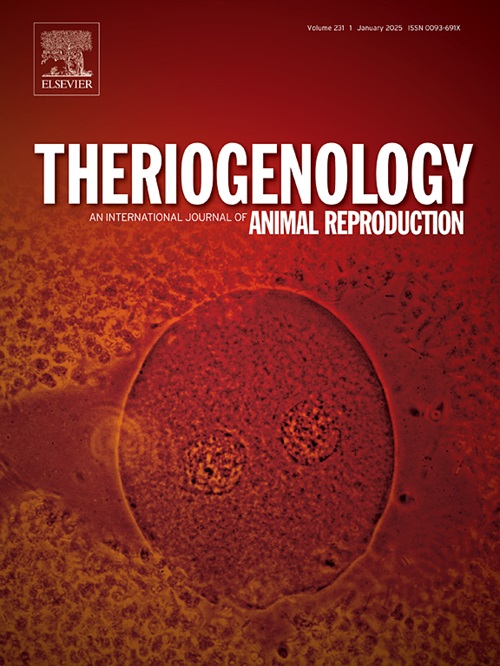miR-24-3p inhibits lipid synthesis and progesterone secretion in chicken granulosa cells via ERK1/2 signaling pathway
IF 2.4
2区 农林科学
Q3 REPRODUCTIVE BIOLOGY
引用次数: 0
Abstract
Normal follicular development is the basis for ovulation in poultry. Our previous sequencing analysis revealed a high expression of miR-24-3p in chicken follicles from degenerated ovaries, suggesting that miR-24-3p may modulate follicular development. Hence, this study investigated the specific mechanisms of miR-24-3p in regulating chicken follicular development. The results revealed that the proliferation, lipid synthesis, and progesterone secretion were significantly inhibited after miR-24-3p overexpression in chicken granulosa cells, vice versa by miR-24-3p knockdown. Dual-specificity phosphatase 16 (DUSP16) and thousand and one amino acid kinase 1 (TAOK1) were identified as potential target genes of miR-24-3p. Further validation revealed that knockdown of DUSP16 and TAOK1 suppressed proliferation, lipid synthesis, and progesterone secretion in chicken granulosa cells. Moreover, we observed that miR-24-3p, along with knockdown of DUSP16 and TAOK1, increased the phosphorylation levels of extracellular signal-regulated kinases 1 and 2 (ERK1/2). Our previous study proved that activation of ERK1/2 inhibited lipid synthesis and progesterone secretion of chicken granulosa cells. In summary, we demonstrated that miR-24-3p targeting DUSP16 and TAOK1 disrupts lipid synthesis and progesterone secretion via ERK1/2 signaling pathway in chicken granulosa cells in vitro. These results may provide a new theoretical basis for resolving miRNAs regulation on reproductive performance of chickens.
miR-24-3p 通过 ERK1/2 信号通路抑制鸡颗粒细胞的脂质合成和孕酮分泌。
正常的卵泡发育是家禽排卵的基础。我们之前的测序分析发现,在退化卵巢的鸡卵泡中,miR-24-3p 的表达量很高,这表明 miR-24-3p 可能会调控卵泡的发育。因此,本研究探讨了 miR-24-3p 调节鸡卵泡发育的具体机制。结果发现,miR-24-3p过表达后,鸡颗粒细胞的增殖、脂质合成和孕酮分泌均受到显著抑制;miR-24-3p敲除后,鸡颗粒细胞的增殖、脂质合成和孕酮分泌均受到显著抑制;miR-24-3p敲除后,鸡颗粒细胞的增殖、脂质合成和孕酮分泌均受到显著抑制。双重特异性磷酸酶 16(DUSP16)和千分之一氨基酸激酶 1(TAOK1)被确定为 miR-24-3p 的潜在靶基因。进一步验证发现,敲除 DUSP16 和 TAOK1 会抑制鸡颗粒细胞的增殖、脂质合成和孕酮分泌。此外,我们还观察到,miR-24-3p 与 DUSP16 和 TAOK1 的敲除一起增加了细胞外信号调节激酶 1 和 2(ERK1/2)的磷酸化水平。我们之前的研究证明,ERK1/2 的激活抑制了鸡颗粒细胞的脂质合成和孕酮分泌。综上所述,我们证明了靶向 DUSP16 和 TAOK1 的 miR-24-3p 可通过 ERK1/2 信号通路干扰体外鸡颗粒细胞的脂质合成和孕酮分泌。这些结果可为解决 miRNAs 对鸡繁殖性能的调控提供新的理论依据。
本文章由计算机程序翻译,如有差异,请以英文原文为准。
求助全文
约1分钟内获得全文
求助全文
来源期刊

Theriogenology
农林科学-生殖生物学
CiteScore
5.50
自引率
14.30%
发文量
387
审稿时长
72 days
期刊介绍:
Theriogenology provides an international forum for researchers, clinicians, and industry professionals in animal reproductive biology. This acclaimed journal publishes articles on a wide range of topics in reproductive and developmental biology, of domestic mammal, avian, and aquatic species as well as wild species which are the object of veterinary care in research or conservation programs.
 求助内容:
求助内容: 应助结果提醒方式:
应助结果提醒方式:


